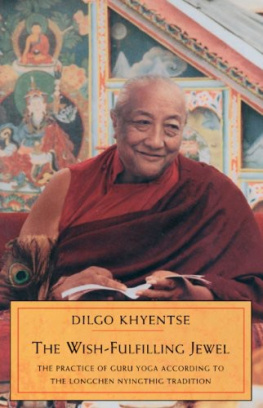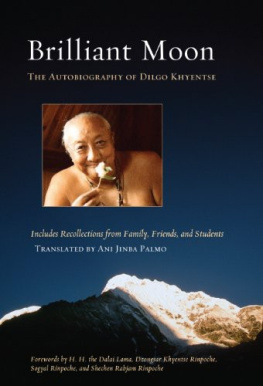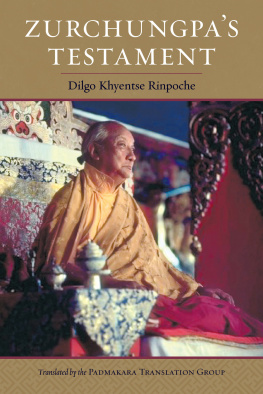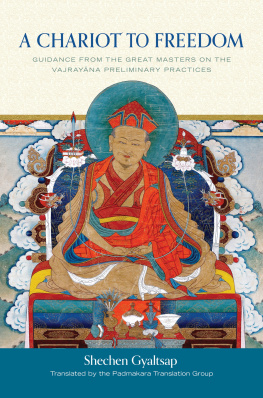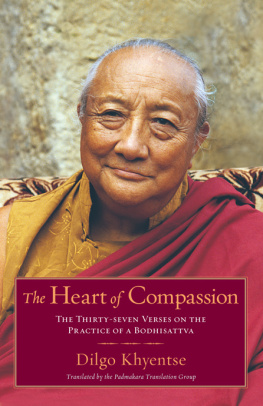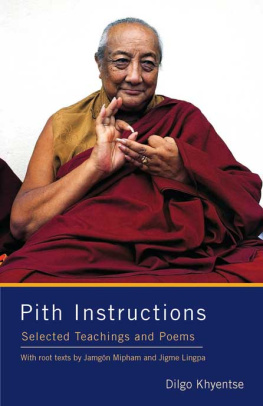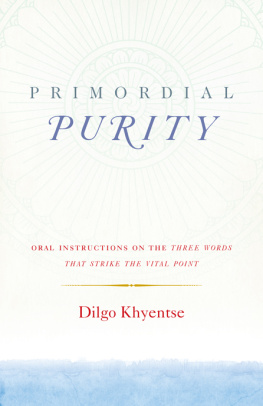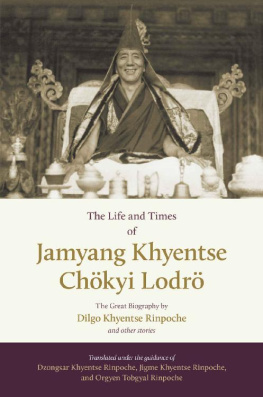ABOUT THE BOOK
In the Tibetan Buddhist tradition, devotion to ones guru or spiritual master is considered to be of the utmost importance in spiritual practice. The instructions of Dilgo Khyentse Rinpoche, based upon the teachings of the great eighteenth-century saint and visionary Rigdzin Jigme Lingpa, focus on the devotional practices of Guru Yoga, Merging with the Mind of the Guru.
DILGO KHYENTSE RINPOCHE (19101991) was a highly accomplished meditation master, scholar, and poet, and a principal holder of the Nyingma lineage. His extraordinary depth of realization enabled him to be, for all who met him, a foundation of loving-kindness, wisdom, and compassion. A dedicated exponent of the nonsectarian Rime movement, Khyentse Rinpoche was respected by all schools of Tibetan Buddhism and taught many eminent teachers, including His Holiness the Dalai Lama. He tirelessly worked to uphold the Dharma through the publication of texts, the building of monasteries and stupas, and by offering instruction to thousands of people throughout the world. His writings in Tibetan fill twenty-five volumes.
Sign up to learn more about our books and receive special offers from Shambhala Publications.

Or visit us online to sign up at shambhala.com/eshambhala.

His Holiness Khyentse Rinpoche
The Wish-Fulfilling Jewel
THE PRACTICE OF GURU YOGA ACCORDING TO THE LONGCHEN NYINGTHIG TRADITION
Dilgo Khyentse
Translated from the Tibetan by
Knchog Tenzin

SHAMBHALA
Boston & London
2013
Shambhala Publications, Inc.
Horticultural Hall
300 Massachusetts Avenue
Boston, Massachusetts 02115
www.shambhala.com
1988 by H. H. Dilgo Khyentse Rinpoche
All rights reserved. No part of this book may be reproduced in any form or by any means, electronic or mechanical, including photocopying, recording, or by any information storage and retrieval system, without permission in writing from the publisher.
Library of Congress Cataloging-in-Publication Data
Rab-gsal-zla-ba, Dil-mgo Mkhyen-brtse, 1910
The wish-fulfilling jewel: the practice of guru yoga according to the Longchen Nyingthig/Dilgo Khyentse: translated from the Tibetan by Knchog Tenzin.
p. cm.
eISBN 978-0-8348-2758-5
ISBN 978-1-57062-452-0 (pbk.)
1. Guru worship (Rite)Buddhism. 2. BuddhismChinaTibet. I. Title
BQ7699.G87R83 1988 87-32250
294.361dc19 CIP
Contents
Publishers Note
This book contains Sanskrit diacritics and special characters. If you encounter difficulty displaying these characters, please set your e-reader device to publisher defaults (if available) or to an alternate font.
T he teachings found here concern a fundamental and most precious practice known as guru yoga. The words guru yoga mean union with the nature of the guru, and in this practice we are given methods by which we can blend our own minds with the enlightened mind of the guru.
It is said that all the buddhas of the three timesthose of the past and the present and those to comeachieve buddhahood through reliance on a spiritual teacher. The essence of reliance on a teacher is unceasing devotion, and the most effective means of generating and sustaining unwavering devotion is precisely the practice of guru yoga. Through this practice, devotion to the teacher takes firm root within us and eventually grows to pervade our entire being. It protects our practice from obstacles and ensures progress on the path. Devotion to the teacher is thus the core of all our spiritual practice, regardless of the particular stages of the path we cultivate. For these reasons, guru yoga is considered the most vital and necessary of all practices and is in itself the surest and fastest way to reach the goal of enlightenment.
Why is the blending of our mind with the gurus mind such an essential practice? Although the guru at first may appear to us in ordinary human form and although he may at first appear to behave in an ordinary human way, his mind really is inseparable in nature from the mind of the Buddha. The qualities of the guru differ in no way from those of a perfectly enlightened buddha.
Actually, the only difference between the guru and the buddhas is that his kindness exceeds that of all the enlightened ones of the past. For instance, Buddha kyamuni left this world over two thousand years ago, while other buddhas, such as Amitbha and Vajrasattva, are dwelling in their respective buddha-fields. They are perfectly enlightened buddhas, but we can neither meet them face to face nor hear their teachings, because our minds are now thick with obscuration. Our guru, on the other hand, has come into this world at this time. We can meet him and receive from him the precious instructions that will lead us out of the mire of sasra to enlightenment. So, although our guru is equal to all the buddhas in his qualities, he exceeds them in his kindness.
The specific text that we will use and explain here is drawn from the Longchen Nyingthig, the profound and extensive cycle of teachings revealed by the great saint and tertn , whose name means Fearless Holder of Awareness. He is also known as Khyentse ser, which means Light Rays of Wisdom and Love, a name given to him in visions. Longchen Nyingthig means Heart Essence of the Great Expanse.
At this point, it is appropriate to offer an account of the origin of the Longchen Nyingthig and in this way strengthen our confidence in the authenticity of these teachings. According to Jigme Lingpa himself, the teachings came to him in the following way:
As the fruit of my fervent prayers in countless lives never to be separate from the compassion and blessing of Urgyen, intending to spend three years in strenuous and one-pointed spiritual practice.
One morning at dawn, as I was engaged in the recitation of the hundred peaceful and wrathful deities,
Not long after this, I dreamed I was in an unfamiliar place that was said to be the celestial field Spontaneous Accomplishment of All Wishes. There I saw, riding on a dragon, Dorje Drol are indissociable. There is no doubt that the son will receive the fathers treasure. He said this and everything vanished.
Several days passed. Then, during the evening of the twenty-fifth day of the tenth month of the Female Fire Ox year [1757], a fiery devotion toward the great master Guru Padmasambhava arose within me, filling my eyes with tears. Memories from a remote past flashed across my mind, and with overwhelming sadness I thought, Here in this land of red-faced men, people live mired in hatred, lust, and ignorance, wallowing in nothing but the most vicious of actions. There is nothing left but a pale shadow of the teachings, and I myself feel like an orphan abandoned in the wilderness. You, compassionate protector, greater than any other buddha, have left this land and gone to the Copper-Colored Mountain. Will I ever be able to meet you?
Tormented by sorrow, I wept. Just at that moment, the air around me became filled with light, and suddenly, standing before me, I beheld a beautiful white snow lioness. I took my seat on her back and we leaped into the limitless immensity of the sky. Soon we arrived at Jarungkhashor, of the dharmakya wisdom.
She handed me a sealed flat wooden casket, and said:
For those with pure perception,
You are King Trisong Detsen.
For those whose perception is less pure,
You are Senge Repa, the cotton-clad Lion Yogi.
Next page
